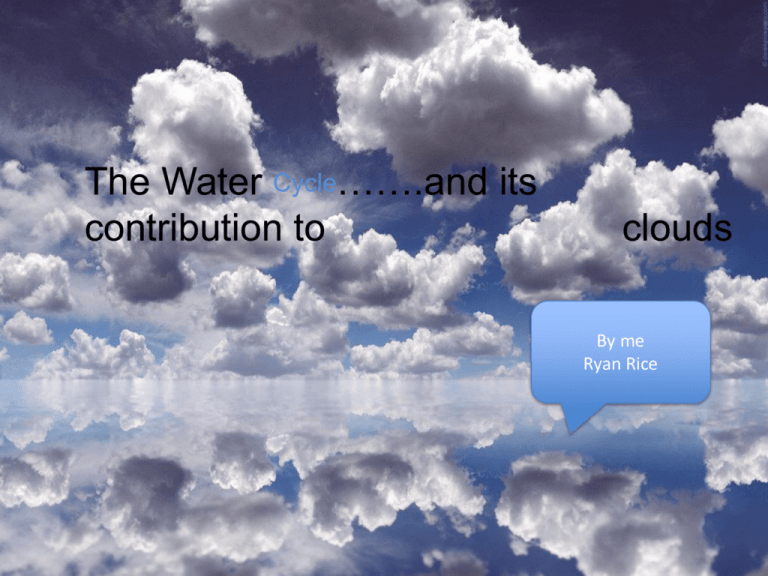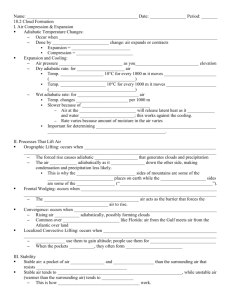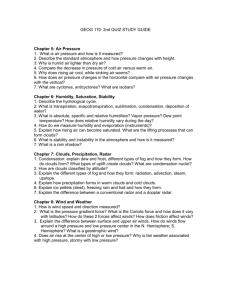
The Water Cycle…….and its
contribution to
clouds
By me
Ryan Rice
Three states of water matter
•Solid
•Liquid
•Gas
To change state, heat must be
•Absorbed, or
•Released
Heat energy
•Measured in calories – one calorie is the heat
necessary to raise the temperature of 1 gram of
water 1 degree Celsius
Latent heat
Stored or hidden heat
Not derived from temperature change
Important in atmospheric processes
Processes
•Evaporation
Liquid is changed to gas
•Condensation
Water vapor (gas) is changed to a liquid
•Melting
Solid is changed to a liquid
•Freezing
Liquid is changed to a solid
•Sublimation
Solid is changed directly to a gas
•Deposition
Water vapor (gas) changed to a solid (e.g., frost in a freezer
compartment)
•Classification based on
Classification
based on
Height
Height
•High clouds – above
6,000 meters
High cloudsTypes
– above
6,000
meters
include
cirrus,
cirrostratus,
cirrocumulus
Middle clouds
2,000 to
6,000tometers
•Middle–clouds
– 2,000
6,000 meters
include
Low cloudsTypes
– below
2,000 meters
altostratus and
altocumulus
•Low clouds – below
2,000 meters
Cirrus Clouds
The most common form of highlevel clouds are thin and often wispy.
Typically found at heights greater
than 20,000 feet (6,000 meters),
Cirrus clouds are composed of ice
crystals that originate from the freezing
of super cooled water droplets.
Generally occur in fair weather and
point in the direction of air movement
at their elevation.
Cumulus Clouds
The Cotton Balls in the Sky
Low clouds – below 2,000 meters
can form low as 300 ft
Types include stratus, stratocumulus, and
nimbostratus (nimbus means “rainy”)
Cumulus clouds are formed as a result of the
process of convection, wherein warm air rises in the
atmosphere and eventually cools down.
Clouds of vertical development
From low to high altitudes are
Called Cumulonimbus
Often/ most of the time,
produce rain showers and
thunderstorms
Altostratus clouds
Stratus – sheets or layers that cover
much of the sky
Middle clouds – 2,000 to 6,000 meters
At dusk, colors are gray or blue-gray,
composed of ice crystals and water
droplets
Adiabatic
Adiabatic temperature changes occur
when heating/cooling
Air is compressed
Motion of air molecules increases
Air will warm
Descending air is compressed due to
increasing air pressure
Air expands
Air will cool
Rising air will expand due to
decreasing air pressure
•Adiabatic rates
Dry adiabatic rate
•Unsaturated air
•Rising air expands and cools at 1˚C per 100 meters
(5.5˚F per 1,000 feet)
•Descending air is compressed and warms at 1˚C per
100 meters
Wet adiabatic rate
•Commences at condensation level
•Air has reached the dew point
•Condensation is occurring and latent heat is being
liberated
•Heat released by the condensing water reduces the
rate of cooling
•Rate varies from 0.5˚C to 0.9˚C per 100 meters
Wet rate is less.
Wet rate is less…
Latent heat is released when Water vapor condenses
Processes that lift air
Very important for weather: lifted air cools adiabatically and
condenses to form clouds. Lifting is generally required to
produce precipitation.
Orographic lifting
•Elevated terrains act as barriers
•Result can be a rain shadow desert
Frontal wedging
•Cool air acts as a barrier to warm air
•Fronts are part of the storm systems called middle-latitude
cyclones
Convergence
Where the air is flowing together and rising (low pressure)
Localized convective lifting
•Localized convective lifting occurs where unequal surface
heating causes pockets of air to rise because of their buoyancy
Orographic lifting
Frontal Wedging
Boundary that separates air masses of
different densities
•Air masses retain their identities
•Warmer, less dense air forced aloft
•Cooler, denser air acts as wedge
•Warm front
Warm air replaces cooler air
Small slope (1:200)
Clouds become lower as the front nears
Slow rate of advance
Light-to-moderate precipitation
•Cold front
Cold air replaces warm air
Twice as steep (1:100) as warm fronts
Advances faster than a warm front
Associated weather is more violent than a warm front
•Intensity of precipitation is greater
•Duration of precipitation is shorter
Fog: fog is like clouds in that both are formed by condensation of
water vapor from the air. Unlike clouds, fog commonly forms by
radioactive cooling rather than by adiabatic cooling (cooling accompanying
lifting)
Types of fog
•Fogs caused by cooling
Advection fog – warm, moist air moves over a cool surface: e.g. the
California marine layer: warm most air moves over the cold California
current; the cooling leads to condensation and fog formation.
Radiation fog
•Earth’s surface cools rapidly
•Forms during cool, clear, calm nights San Joaquin Valley tulle fog!!
Upslope fog
•Humid air moves up a slope
•Adiabatic cooling occurs (like cloud formation)
Contrails or vapor trails are
condensation trails and artificial cirrus
clouds made by the exhaust of aircraft
engines or wingtip vortices which
precipitate a stream of tiny ice crystals
in moist, frigid upper air.
However, contrails generated by
engine exhaust are inevitably linked
with typical fuel combustion pollutants.
Contrails might also be considered
visual pollution.
September 11, 2001 climate impact study.
It had been hypothesized that in regions such
as the United States with heavy air traffic,
contrails affected the weather, reducing solar
heating during the day and radiation of heat
during the night by increasing the Albedo.
Measurements did show that without contrails
the local diurnal temperature range was about 1
degree Celsius higher than immediately before;
Lets watch a movie……
History Channel Documentary Validates
Chemtrails and Weather Warfare
http://www.youtube.com/watch?v=NVjI0uA9L8&feature=related
Ahh finally…the CONCLUSION
The Earth’s climate has many drivers
that influence its behavior. The most
abundant one on the earth’s surface is
Water. Water moves around the earth in
many different processes, any where from
Evaporation and Condensation to freezing
and melting. All of these processes either
release or absorb heat. When this heat is
released, very intense storm systems.
Clouds are formed when millions and
millions of ice crystals come together.
Work Cited
Warming and the Future of Humanity”. 2008. Book Surge p\Publishing,
USA
Crystal Link/ Contrails/ Chemtrails.
http://www.crystalinks.com/chemtrails.html
Hayden c. Howard. “ A Primer on CO2 and Climate second edition”.
2008. Vales Lake Publishing
Weather Forecasting Cloud Chart.
http://web2.airmail.net/danb1/clouds.htm
2009 Pearson Prentice Hall Inc. Earth Science 12th edition; Tarbuck and
Lutgens
Windows to the Universe. “ Global Warming, Clouds and Albedo”.
http://www.windows2universe.org/earth/climate/warming_clouds_albe
do_feedback.html
“The Scale of the Universe” Stumble Upon.
http://www.stumbleupon.com/su/1FrxcM/www.newgrounds.com/porta
l/view/525347








